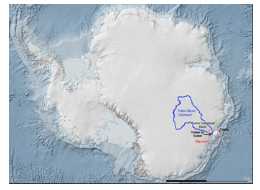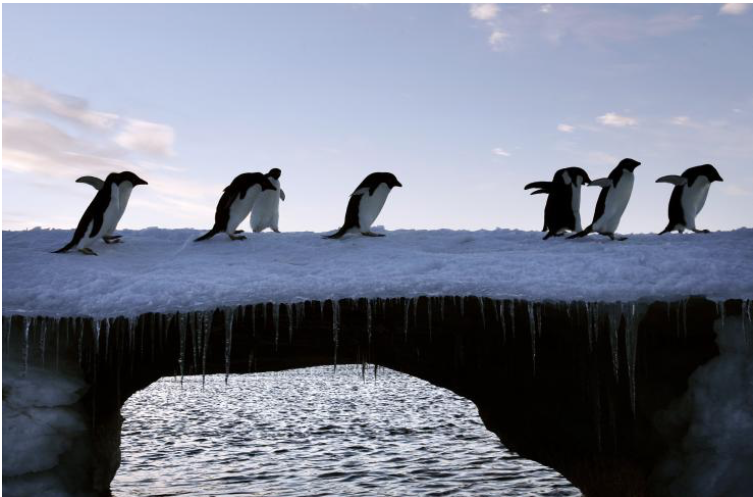CommentsPLANET WATCH--The planet’s biggest nightmare is coming to life. It may be a bigger threat much sooner than ever before realized simply because it’s accelerating!
East Antarctica, the world’s largest body of water trapped in ice, is knocking the socks off expectations. Along the way, it’s the world’s most horrifying surprise, yet nobody really knows how it will play out because the science is still in early stages.
Nevertheless, a formidable issue is at hand: Vincennes Bay in East Antarctica is home to humongous glaciers, like Totten Glacier (2,400 square miles), which is the largest glacier in the bay and equivalent to at least 11 feet of sea level rise alone, but it is only one of several glaciers in Vincennes Bay.
Recent NASA research indicates that four glaciers west of Totten Glacier in Vincennes Bay have receded by 9 feet since 2008. Heretofore, there was no measured change in these glaciers… period!
Surprisingly, within one decade there’s measurable loss of 9 feet after years and decades and centuries upon centuries of East Antarctica stability. This is disturbing and begs the question of what if the melting accelerates more, and more, and keeps on accelerating more than previous rates of acceleration. Then what?
According to NASA: “East Antarctica has the potential to reshape coastlines around the world through sea level rise, but scientists have long considered it more stable than its neighbor, West Antarctica. Now, new detailed NASA maps of ice velocity and elevation show that a group of glaciers spanning one-eighth of East Antarctica’s coast have begun to lose ice over the past decade, hinting at widespread changes in the ocean.” (Source: More Glaciers in East Antarctica Are Waking Up, NASA, Dec. 10, 2018).
 Additionally, and in the opposite direction, or east of Totten Glacier, (illustration, left) a “collection of glaciers” doubled their rate of ice loss since 2009. By all appearances, the past 10 years has served to alter East Antarctica into early stages of a meltdown phase. As previously mentioned, this is an unexpected event.
Additionally, and in the opposite direction, or east of Totten Glacier, (illustration, left) a “collection of glaciers” doubled their rate of ice loss since 2009. By all appearances, the past 10 years has served to alter East Antarctica into early stages of a meltdown phase. As previously mentioned, this is an unexpected event.
Meanwhile, for some time now at the opposite side of the continent, West Antarctica has been in the grip of rapid breakdown. In fact, Pine Island Glacier in West Antarctica is one of the fastest-flowing ice streams on the planet.
For example, Pine Island Glacier is dispensing icebergs into the Amundsen Sea from ice shelves with increasing frequency, which is troubling, to say the least. The most recent, Iceberg B-46 (87 sq. miles) split off in October 2018. Pine Island Glacier (equal to 1.7 feet of sea level rise) shed icebergs in 2001, 2007, 2011, 2013, 2015, 2017, and 2018.
Ice shelves are floating ice sheets that do not contribute much to rising sea levels since they are already mostly afloat, thus displacing their own weight. They extend out over the water from icy landmasses but significantly, as a matter of course, serve as a backstop or physical barrier of ice sheets, holding back rapid glacial ice flow into ocean waters.
Therefore, losing ice shelves out of the ordinary in rapid succession is obviously an ominous signal of trouble dead ahead, meaning glacial ice flow that directly impacts sea levels is freed-up, up and away.
Typically, in years past, West Antarctica shed an iceberg every six years whereas recent activity has shockingly compressed time over the past two decades to, respectively, once every 6 years, 4 years, 2 years, 2 years, 2 years, and most recently 1 year. That’s powerful evidence of a major change in ice sheet behavior.
For that reason, among others, scientists have always focused on West Antarctica’s instability rather than on East Antarctica. Now, in addition to serious concerns about the western region of the continent, surprise, surprise, after analyzing 40 years of data and satellite images, East Antarctica is no longer considered “immune to climate change.”
Not only that, but unfortunately this new data about East Antarctica is at odds with a significant 2018 study that showed less reason for concern and therefore, assuming this new information is thoroughly validated, “could dramatically reshape projections of sea level rise….” (Source: Alex Fox, East Antarctica’s Ice is Melting at an Unexpectedly Rapid Clip, New Study Suggests, Science, Jan. 14, 2019).
To say this news is disheartening is comparable to standing dockside at Berth 44, Southampton on April 10, 1912, waving goodbye to passengers on the Titanic.
East Antarctica destabilization, according to Eric Rignot, glaciologist, University of California/Irvine: “The more we look at this system the more we realize this is a fragile system… Once these glaciers are destabilized there is no red button to press to stop it,” Ibid.
Antarctica’s Ice Sheet is larger than the U.S. and India combined. Its three major ice sheets contain 70% of the planet’s fresh water in ice.
One catalyst behind ice sheet misbehavior is ocean absorption of 90% of anthropogenic global warming, which manages to flow underneath the massive ice sheets.
Additionally, global warming multiplies 2xs via “polar amplification,” meaning Antarctica’s surface temperatures increase twice as fast as the global average. This is a unique aspect of high latitude polar temperatures up north in the Arctic as well as down south in Antarctica.
Not only are temperatures magnified 2xs in high polar latitudes, but also in everyday contemporary life, global warming is striking hard, which does not bode well as to further magnification of polar temperatures.
For example, Australia sizzled like a blazing hot oven in late 2018 as temperatures exceeding 42°C (107°F). Roads melted, tens of thousands of bats dropped dead (many found on city streets) and hundreds of thousands of bony herring, golden and silver perch and Murray cod died, demonstrating the impact of erratic and excessive temperature variations.
Meantime, in similar fashion, due south of Australia, Antarctica’s ice sheets rumbled and tumbled, threatening inconvenience for coastal communities as a best-case scenario, but maybe (most probably) much worse.
As it happens, the world is changing right before humanities’ eyes. Nowadays, global warming is more than a threat of rising sea levels, which in and of itself looks grim, indeed, never so grim as of now, but it’s also turned into a vicious mass killer.
Still, the biggest questions of the 21st century remain unanswered: What can be done and who’ll take charge? After all, greenhouse gases are a fact of life not easily removed.
One answer: Build seawalls like Trump International Golf Links & Hotel - Ireland, which received a permit to build two seawalls in December 2017. Trump’s 2016 permit application cited “climate change, rising sea levels, and extreme weather conditions” as reasons for getting the permit.
(Robert Hunziker lives in Los Angeles and is a CityWatch contributor. He can be reached at [email protected].) Prepped for CityWatch by Linda Abrams.
















